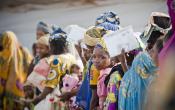Congo
Operation: Congo
Location
{"longitude":16,"latitude":0,"zoom_level":0}
Latest update of camps and office locations 21 Nov 2016. By clicking on the icons on the map, additional information is displayed.
Key Figures
| 2016 end-year results | |
| 94% | of primary school-aged children were enrolled in primary education |
| 80% | of the applicants had access to status determination procedure |
| 640 | people with specific needs received support |
| 100 | people of concern were provided with sectorial cash vouchers |
| 2017 planning figures | |
| 50% | of primary school-aged children from DRC will be enrolled in primary education |
| 40% | of Central African refugees will receive services for their specific needs |
| 10% | of refugees and asylum-seekers from DRC (aged 18-59 years) will be supported by UNHCR to develop their own business or self-employment |
| 60 | reported cases of sexual and gender-based violence among refugees and asylum-seekers |
Latest Updates and Related Links
People of Concern
37%
Increase in
2016
2016
| 2016 | 71,598 |
| 2015 | 52,152 |
| 2014 | 59,105 |

[["Refugees",46457],["Asylum-seekers",6675],["IDPs",15303],["Returned refugees",11],["Others of concern",3152]]
Loading ...
Congo
< Back
2016
{"categories":[2012,2013,2014,2015,2016,2017],"budget":[30.58222392,32.08599964,37.62501547,35.34159306,32.00000031,28.64266715],"expenditure":[13.87705717,14.68758224,13.69277603,10.261615,9.33211215,null]}
{"categories":[2012,2013,2014,2015,2016,2017],"p1":[30.58222392,32.08599964,37.62501547,35.34159306,32.00000031,27.84395715],"p2":[null,null,null,null,null,null],"p3":[null,null,null,null,null,null],"p4":[null,null,null,null,null,0.79871]}
{"categories":[2012,2013,2014,2015,2016,2017],"p1":[13.87705717,14.68758224,13.69277603,10.261615,9.33211215,null],"p2":[null,null,null,null,null,null],"p3":[null,null,null,null,null,null],"p4":[null,null,null,null,null,null]}
Loading ...
CHOOSE A YEAR
- 2014
- 2015
- 2016
- 2017
Working environment
The government reported attacks in the Pool department of the Republic of Congo, which led to the internal displacement of an estimated 15,500 people in November 2016.Refugees and especially those living in urban areas were affected by the socio-economic situation of the country and those working in the construction industry lost their jobs. In addition, the authorities implemented measures restricting access to some income-generating activities such as small trade and driving of taxis. Several cases of survival sex were identified, increasing the need for assistance.
While refugees over the age of 16 were provided with refugee identification cards after the verification exercise held in 2015 and 2016, refugees continued to face protection risks due to police operations. Furthermore, the Government of the Congo lifted the prima facie recognition of Central Africans refugees, which resulted in thousands of Central African asylum seekers not being provided with refugee ID cards.
Population trends
- The total number of people of concern increased by 27 per cent, from 52,151 to 71,597 at the end of 2016.
- Security incidents in the Pool department triggered displacement of a further 15,500 people within the country in late 2016.
- The number of asylum-seekers increased from 4,342 in 2015 to 6,675 in 2016 since the Republic of the Congo lifted the prima facie recognition for Central African refugees in 2016.
Achievements and impact
- The Government’s capacity has been increased to ensure that the relevant body could handle the exemption process on prima facie recognition and undertake accelerated status determination procedures for Central African asylum-seekers.
- Training sessions have been organized on refugee’s rights and obligation, on sexual and gender-based violence (SGBV) as well as on child protection issues.
- People with specific needs were assisted in paying deposits for housing and given cash assistance to cover their basic needs.
- Discussions with national authorities have been initiated in order to develop a durable solutions strategy as well as a local integration component.
Unmet needs
- Livelihood-generating activities that would lead refugees to self-reliance could not be carried out fully.
- Only one third of the identified SGBV survivors received support.
- Due to funding shortfall, only 10 per cent of the 700 refugee children identified at risk benefited from best interest assessment and determination (BIA/BID).
The Congo hosts 52,000 refugees, including 24,600 from the Central African Republic (CAR) and 15,000 from the Democratic Republic of the Congo (DRC).
The emergency response for CAR refugees is likely to continue in 2016 given the ongoing volatile situation. In addition to the multisectoral assistance provided, including health, shelter, clean water, sanitation, education, nutrition and non-food items, it is expected that a durable solutions strategy may be initiated in 2016.
UNHCR will continue to build the capacity of Congolese authorities, with the aim of ensuring that standard operational procedures are carried out during refugee status determination.
For the Rwandan and Angolan former refugees in the Congo, advocacy will be conducted in order for them to benefit from educational and social support. The Office will also work with the Government on an alternative status for these people of concern to ensure their legal integration and, ultimately, the issuance of residence permits.
The repatriation of 10,000 refugees from the DRC is planned in 2016. For those who opted for local integration, self-reliance activities will be a priority.
In 2016, 100 people of concern will receive production kits or support with agriculture, livestock and fishing activities.


